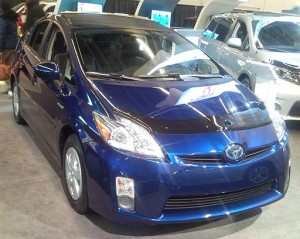 According to Toyota, its 2016 Prius engine that delivers up to 40% thermal efficiency will be the most efficient yet. The automaker made this announcement during the Annual Spring Congress for Japan’s Society of Automotive Engineers that was held last week, while giving additional details concerning the engine. The company said that improvement of the exhaust gas recirculation (EGR) limit from 21 to 28 percent is what will improve the engine’s efficiency. Following this boost, the 2016 Prius hybrid car’s engine will become a leader in terms of efficiency. This is in comparison to the previous two generations whose thermal efficiency was at 37 %. The current third generation has a 1.8-liter engine with an efficiency of 38.5%. Last year Toyota made clear of its intention to upgrade the fuel efficiency of its next generation of Prius by 15%. It therefore seems that Toyota has achieved its goal with the 2016 Prius.
According to Toyota, its 2016 Prius engine that delivers up to 40% thermal efficiency will be the most efficient yet. The automaker made this announcement during the Annual Spring Congress for Japan’s Society of Automotive Engineers that was held last week, while giving additional details concerning the engine. The company said that improvement of the exhaust gas recirculation (EGR) limit from 21 to 28 percent is what will improve the engine’s efficiency. Following this boost, the 2016 Prius hybrid car’s engine will become a leader in terms of efficiency. This is in comparison to the previous two generations whose thermal efficiency was at 37 %. The current third generation has a 1.8-liter engine with an efficiency of 38.5%. Last year Toyota made clear of its intention to upgrade the fuel efficiency of its next generation of Prius by 15%. It therefore seems that Toyota has achieved its goal with the 2016 Prius.
Although a 40% thermal efficiency is a significant increase, Toyota had originally hoped for more. Toyota’s Koichi Nakata in 2011 said that the automaker’s hope was to reach a thermal efficiency of 45% for its hybrid cars. Some of the ways in which Toyota managed to achieve an additional 1.5% thermal efficiency as explained by Nikkei Technology Online include straightening the intake port, recirculating more exhaust gases and redesigning the shape of the piston. The heat capacity increases when the EGR limit and hence, the amount of cooled exhaust gas being circulated is increased. This in turn lowers the gas temperature in the cylinder. This prevents knocking and the cooling loss may reduce by up to 8% in comparison to the existing model. Toyota will increase combustion speed in order to increase the EGR limit. It is important to disturb airflow inside the cylinder to realize the high speed combustion. The tumble ratio, which is the ratio between the swirl flow in the piston movement direction and then in the axial direction, was increased by the company to 2.8 from 0.8. This method can easily disturb the airflow near the top dead center for the piston.
The tumble ratio is increased by straightening the lower side of the suction port to make the airflow a perpendicular vortex. According to estimates made by Toyota, the mean turbulent velocity of the gas inside a cylinder, in the compression stroke with a 2,000 rpm engine speed, can be increased to 3.4 m/s from 2.5 m/s. Additionally, the piston’s top face shape was changed by Toyota to allow easy disturbance of the airflow inside the cylinder.